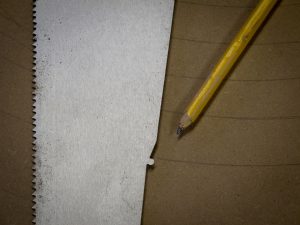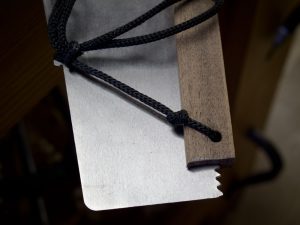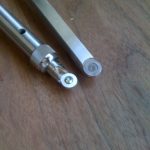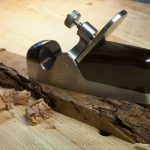We may receive a commission when you use our affiliate links. However, this does not impact our recommendations.
If you own a saw that has a “nib,” a decorative nipple-looking thing on the toe of your saw, someone will ask you what it’s for.
The best answer is: It’s decorative.
But that doesn’t stop woodworkers from coming up with uses for it. Here are two good ones.
1. As a place to tie on your saw’s “keeper.” When I travel with handsaws that aren’t in a tool chest I protect their teeth with some sort of wooden guard. Some of these keepers clip on. Some of them fit with friction. The best way I have found to secure a keeper is to tie it to the saw.
One string goes through the keeper and through the saw’s tote. The other string goes through the keeper and behind the nib. If the saw doesn’t have a nib, the string tends to slip off easily.
2. Use the nib as a makeshift compass. Carpenter Carl Bilderback showed me this trick. You first drive a nail or screw at the centerpoint of the arc or circle you wish to draw. Place the saw’s nib against the nail or screw. Place a pencil into the gullet of one of the teeth of the saw.
With one hand push the pencil around. With the other hand push the nib against the nail. After a few trials you’ll get the hang of it.
I’ve tried some of the less ridiculous uses for the nib (using it to score an edge to prevent splintering, filing it into a tooth for various reasons), but these are the only two uses that I actually would use.
— Christopher Schwarz
Want to learn to sharpen your handsaws? Check out this DVD from Ron Herman. There are many ways to sharpen saws; I have found Herman’s methods appeal to a lot of beginners. Check it out at shopwoodworking.com.
Here are some supplies and tools we find essential in our everyday work around the shop. We may receive a commission from sales referred by our links; however, we have carefully selected these products for their usefulness and quality.












Pret Woodburn (friends with Peter Follansbee) uses a saw nib in the attached video. Looks plausible to me: http://blueoakblog.wordpress.com/2014/04/04/still-in-vieques/
With all the other questions that are begging for answers, the saw nib question has certainly become a time consumer.
Just a morning thought. A nib is that tasty carrot on the back of an otherwise boring saw plate enticing us to pick it up. A quality tool should first beg you to pick it up amongst all the others and try it. It should second, out perform all the others so you will again and again pick it up instead of the others. 🙂
Nibs must be a “modern” decoration. None of my grandfather’s 125 plus years old saws have nibs, nor does my 60 year old rip handsaw!
When I saw the opener photo, I thought you were going to make a case for the nib as a pencil sharpener.
I have some early English hand saws with 2-3 decorative nibs, and I have seen early 18th century saws with a decorative hook on the top end. As Henry Disston himself said in the 1800’s it is a decorative way to end the top. It matches the very decorative designs of the early saw handles, beautifully sculptured. I agree it wonderfully serves the function of tying on the wood tooth guard. My saws are to sharp to use as a compass. You would easily cut yourself! But you are right that it is a common discussion point for many collectors.
Duh—nib was always intended to secure saw cover to guard teeth (according to my reference books).
I am convinced that the nib was to retain the protective keeper. Look at the other end of the saw. The handle. Here a ledge, nob or circular rebate was more often provided than not to take the cord or leather thong securing the protector. These feature are often not present on backed saws presumably because they were kept and transported in chest.
The compass use is very interesting.
Regards.
I was told by elderly carpenter (now long gone) that the “nib” was used to clean out the kerf…
I find it’s quite useful for starting woodworking arguments.